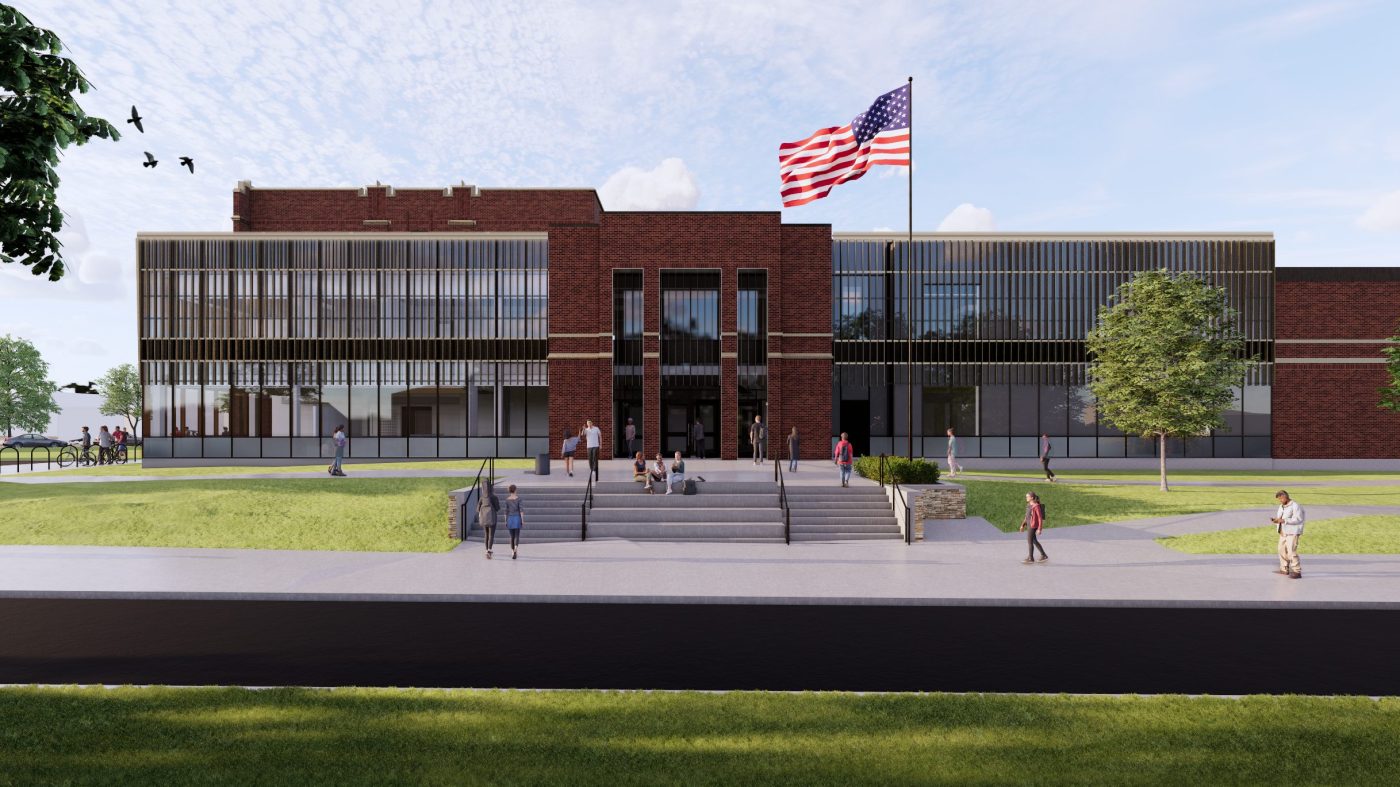
Students at St. Paul’s Hidden River Middle School relocate during $43 million renovation
As Hidden River Middle School in St. Paul’s Mac-Groveland neighborhood undergoes an estimated $43 million renovation that will introduce sustainable features and update the 1920s building, students and administrators will begin this school year in the nearby Wilson building.
By having students in Wilson, located at 631 Albert St. N., during the remodeling process, construction time on Hidden River will be reduced by two years, said Jackie Turner, St. Paul Public Schools executive chief of administration and operations, during a July 16 St. Paul school board meeting. That time reduction is estimated to save the school district somewhere between $3 million to $4 million, said Jonathan Pettigrew, St. Paul Public Schools manager of facility programming.
Students are expected to move back to Hidden River Middle School, formerly Ramsey Middle School and located at 1700 Summit Ave., for the 2025 to 2026 school year once construction is completed in fall 2025.
Groundbreaking on the project took place in late May. The forecasted cost is $43 million against its original approved budget of $54 million, according to St. Paul Public Schools officials. The $43 million is subject to change in the event of unforeseen construction issues, according to SPPS officials.
Where is the $43 million going?
Designed by DLR Group and contracted with Kraus-Anderson, the project will add 10,800 square feet of additions to the building’s more than 98,000 square-feet, according to Angie Otteson, St. Paul Public Schools Facilities Department project manager, and include a full interior remodel. The renovation will include a new main entrance at the northeast corner of the building and administrative and mechanical additions, as well as community spaces students can use to work outside of the classroom and environmental upgrades.
Plans include retaining the east façade on Cambridge Street which includes Collegiate Gothic and Art Deco architectural styles and is part of the original 1926 portion of the building. The Hidden River building is not classified as historic, but is within the West Summit Avenue Heritage Preservation District. The Summit Avenue district’s period of significance is 1885 to 1938, according to a St. Paul Heritage Preservation Commission application for the school from April. The Hidden River Middle School building was built in the 1920s. Further additions to the building in the 1960s, 1970s and 1990s were made outside of the district’s period of historical significance.
Interior alterations made to the building are outside the scope of HPC review, according to the application. New construction was designed to be secondary to the historic section of the building.
“The materials and colors used in the new addition either reflect the existing building through clear glass or connect to the light and dark brown tones of the existing brick and stone façade,” according to the application. SPPS received a Heritage Application Certificate on April 22 after the commission approved the exterior design for the project.
According to the St. Paul Public Schools Facilities Master Plan, 60 percent of the district’s buildings are more than 60 years old, “designed in an era not suited to 21st century teaching and learning.”
District officials have referred to buildings that are temporarily used during construction periods — such as Wilson — as “swing space” and have discussed that use for other buildings, including JJ Hill Montessori.
Going into 2025, other major renovation projects for the district include American Indian Magnet with a budget of $53.3 million, Barack and Michelle Obama Elementary School at $72.3 million, Bruce Vento at $89.9 million and Highland Park Middle School at $49.5 million. Construction is expected to be complete for Bruce Vento, Barack and Michelle Obama Elementary and Hidden River in fall 2025.
Environmental, other upgrades
A heating and cooling system using Hidden River’s natural aquifer which lies beneath school grounds will be one of the sustainable features of the remodel. It also will involve sustainable building materials and native and drought-resistant landscaping.
Otteson said the project team will utilize a federal tax credit available through the Inflation Reduction Act for the project.
There also will be a video screen in the entry building to allow students to see data on energy consumption in the school, Otteson said.
“So it’s not just ‘it’s happening in the background,’ it’s a part of the school. It’s represented in the entryway and it’s communicated to everybody that walks in,” she said.
Other features will include renovated and reconfigured classrooms and kitchen, grade-specific levels, community hubs, a secure-entry vestibule, new administrative offices, inclusive restrooms, and updated electrical and HVAC features.
About 30 percent of the project’s budget is dedicated to the school’s new building-wide mechanical system, as well as its aquifer-based heating and cooling system, according to Otteson; 20 percent is dedicated to structure, such as windows and doors; 20 percent is dedicated to interior finishes and built-ins, including equipment, and 10 percent is dedicated to lighting, power and security, with smaller percentages going to site improvements, demolition, furniture and audio-visual classroom equipment.
“We also know that middle schoolers are very social and really striving to figure out how to connect, how to belong, who they’re going to become, and that happens more easily when students are able to connect, and so creating spaces for our grade-level teams and small group work to happen more naturally is the goal of some of the facilities changes that are happening at 1700 Summit Avenue,” said Hidden River Middle School principal Teresa Vibar.
Former Wilson Junior High to house students
Wilson held around 150 high school students in the Limited English Achievement Program until 2023 when they moved to John A. Johnson Elementary, leaving the Wilson building empty. Hidden River Middle School has a student population of around 600, according to Vibar.
RELATED: High school for immigrants to change buildings as St. Paul district adds to reorganization
Hidden River Middle School, which includes grades 6th through 8th, had 675 students enrolled for the 2014 to 2015 school year, according to district data. 593 students were enrolled for the 2019 to 2020 school year and 588 students were enrolled for the 2023 to 2024 school year.
Interior renovations on Wilson to prepare for the temporary relocation of Hidden River students included adjusting classroom sizes and converting a locker room into an expanded cafeteria. Parents also received maps on pickup and drop-off locations and bike parking for students in back-to-school packets and have been invited to tour Wilson during an Aug. 28 open house for students and families.
Residents in the area will also continue to be updated on traffic and other transition changes, Otteson said. More information on Hidden River and district projects is available at hiddenriver.spps.org and spps.org/builds.
While the change may be hard, families and students of Hidden River Middle School are resilient, Vibar said.
According to the St. Paul Public Schools website, district facilities are considered “to receive improvements based on the District’s criteria for prioritization and an impact score based on need. Projects are subsequently scheduled for improvements based on these metrics as well as other considerations.”
Hidden River, which was built in the 1920s, met all the criteria needed to put it at the top of the list for projects like this, said Kathy Wallace, St. Paul Public Schools interim director of facilities.
Related Articles
Black students are still kicked out of school at higher rates despite reforms
Want cheaper college? Pay interest while in school
Minnesota student math, reading scores still much lower than pre-pandemic levels, statewide assessment shows
University of Minnesota regents reject call to divest financial stakes in Israel
Stillwater starts school year with a familiar issue: bus headaches

